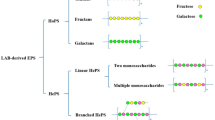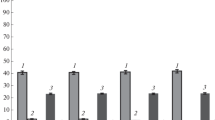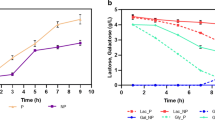Abstract
Exopolysaccharide (EPS) metabolism was studied in a galactose-negative strain of Lactobacillus delbrueckii subsp. bulgaricus, using two different approaches. Firstly, using both the parent strain and a chemically induced mutant with higher yield and specific productivity of EPS than the parent, comparative information was obtained relating to enzyme activities and metabolite levels associated with EPS formation when grown on lactose. Under continuous culture conditions (D=0.10 h−1), the higher metabolic flux towards EPS formation in the mutant strain relative to the parent appeared to be mediated by raised levels of UDP-glucose pyrophosphorylase (UGP). Marginally raised UDP-galactose 4-epimerase (UGE) activity in the mutant strain suggested that this enzyme could also play a role in EPS overproduction. The second approach involved investigating the effect of growth rate on sugar nucleotide metabolism in the parent, as it is known that EPS production is growth-associated in this strain. UGE activity in the parent strain appeared to increase when the growth rate was elevated from 0.05 to 0.10 h−1, and further to 0.35 h−1, conditions that can be associated with higher levels of metabolic flux to EPS formation. Concurrent with these increments, intracellular ATP levels in the cell were raised. In both investigations glucose-6-phosphate accumulated pointing to a constriction at this branch-point, and a limitation in the flow of carbon towards fructose-6-phosphate or glucose-1-phosphate. The changes in metabolism associated with enhanced flux to EPS provide guidance as to how the yield of Lactobacillus delbrueckii subsp. bulgaricus EPS can be improved.





Similar content being viewed by others
References
Bernstein RL (1965) Control aspects of uridine 5′-diphosphate and thymidine 5′-phosphate glucose synthesis by microbial enzymes. J Biol Chem 240:391–397
Bevill RD (1974) Deoxythymidine-5′-diphosphoglucose (dTDPG) (Metabolites: Nucleic Acids, Purines, Pyrimidines, Nucleosides, Coenzymes). In: Bergmeyer HU (ed) Methods of enzymatic analysis, 2nd English edn, vol 3. Academic, London, New York (translated from the 3rd German edn, Verlag Chemie, Weinheim, Germany), pp 2217–2220
Boels IC, Ramos A, Kleerebezem M, de Vos WM (2001) Functional analysis of the Lactococcus lactis galU and galE genes and their impact on sugar nucleotide and exopolysaccharide biosynthesis. Appl Environ Microbiol 67:3033–3040
Boels IC, Kleerebezem M, de Vos WM (2003) Engineering of carbon distribution between glycolysis and sugar nucleotide biosynthesis in Lactococcus lactis. Appl Environ Microbiol 69:1129–1135
Cook AM, Urban E, Schlegel HG (1976) Measuring the concentrations of metabolites in bacteria. Anal Biochem 72:191–201
De Vos WM, Vaughan EE (1994) Genetics of lactose utilization in lactic acid bacteria. FEMS Microbiol Rev 15:216–237
Degeest B, De Vuyst L (2000) Correlation of activities of the enzymes α-phosphoglucomutase, UDP-galactose 4-epimerase, and UGP with exopolysaccharide biosynthesis by Streptococcus thermophilus LY03. Appl Environ Microbiol 66:3519–3527
Dubois M, Gilles KA, Hamilton JK, Rebers PA, Smith F (1956) Colorimetric method for determination of sugars and related substances. Anal Chem 28:350–356
Escalante A, Wacher-Rodarte C, Garcia-Garibay M, Farres A (1998) Enzymes involved in carbohydrate metabolism and their role on exopolysaccharide production in Streptococcus thermophilus. J Appl Microbiol 84:108–114
Fordyce AM, Crow VL, Thomas TD (1984) Regulation of product formation during glucose or lactose limitation in nongrowing cells of Streptococcus lactis. Appl Environ Microbiol 48:332–337
Garrigues C, Loubierre P, Lindley ND, Cocaign-Bousquet M (1997) Control of the shift from homolactic acid to mixed-acid fermentation in Lactococcus lactis: predominant role of the NADH/NAD+ ratio. J Bacteriol 179:5282–5287
Gassem MA, Schmidt KA, Frank JA (1997) Exopolysaccharide production from whey lactose by fermentation with Lactobacillus delbrueckii subsp. bulgaricus. J Food Sci 62:171–173
Gilbert JM, Matsuhashi M, Strominger JL (1965) Thymidine diphosphate 4-acetamido-4,6-dideoxyhexoses. II. Purification and properties of thymidine diphosphate d-glucose oxidoreductase. J Biol Chem 240:1305–1308
Goh KT, Haisman DR, Singh H (2004) Development of an improved procedure for isolation and purification of exopolysaccharides produced by Lactobacillus delbrueckii subsp. bulgaricus NCFB 2483. Appl Microbiol Biotechnol 67:202–208
Grobben GJ, Smith MR, Sikkema J, De Bont JAM (1996) Influence of fructose and glucose on the production of exopolysaccharides and the activities of enzymes involved in the sugar metabolism and the synthesis of sugar nucleotides in Lactobacillus delbrueckii subsp. bulgaricus NCFB 2772. Appl Environ Microbiol 46:279–284
Guedon E, Payot S, Desvaux M, Petitdemange H (1999) Carbon and electron flow in Clostridium cellulolyticum grown in chemostat culture on synthetic medium. J Bact 181:3262–3269
Guedon E, Desvaux M, Petitdemange H (2000) Kinetic analysis of Clostridium cellulolyticum carbohydrate metabolism: importance of glucose 1-phosphate and glucose 6-phosphate branch points for distribution of carbon fluxes inside and outside cells as revealed by steady-state continuous culture. J Bact 182:2010–2017
Jensen PR, Hammer K (1998) Artificial promoters for metabolic optimization. Biotechnol Bioeng 58:191–195
Keppler D, Decker K (1985) Uridine-5′-diphosphoglucose; uridine-5′-diphosphogalactose (Metabolites 2: Tri-and Dicarboxylic Acids, Purines, Pyrimidines and Derivatives, Coenzymes, Inorganic Compounds). In: Bergmeyer HU, Bergmeyer J, Graßl M (eds) Methods of enzymatic analysis, 3rd edn, vol VII. Verlagsgesellschaft, Weinheim, pp 524–530
Kimmel SA, Roberts RF (1998) Development of a growth medium for exopolysaccharide production by Lactobacillus delbrueckii ssp. bulgaricus RR. Int J Food Microbiol 40:87–92
Kitazawa H, Toba T, Itoh T, Kumano N, Adachi S, Yamaguchi T (1991) Antitumoral activity of slime-forming encapsulated Lactococcus lactis ssp. cremoris isolated from Scandinavian ropy sour milk “viili”. Animal Sci Technol 62:277–283
Kitazawa H, Itoh T, Tomioka Y, Mizugaki M, Yamaguchi T (1996) Induction of IFN-γ and IL-α production in macrophages stimulated with phosphopolysaccharide produced by Lactococcus lactis ssp. cremoris. Int J Food Microbiol 31:99–106
Kitazawa H, Harata T, Uemura J, Saito T, Kaneko T, Itoh T (1998) Phosphate group requirement for mitogenic activation of lymphocytes by an extracellular phosphopolysaccharide from Lactobacillus delbrueckii ssp. bulgaricus. Int J Food Microbiol 40:169–175
Laws A, Gu Y, Marshall V (2001) Biosynthesis, characterisation, and design of bacterial exopolysaccharides from lactic acid bacteria. Biotechnol Adv 19:597–625
Looijesteijn PJ, Boels IC, Kleerebezem M, Hugenholtz J (1999) Regulation of exopolysaccharide production by Lactococcus lactis subsp. cremoris by the sugar source. Appl Environ Microbiol 65:5003–5008
Looijesteijn PJ, van Casteren WHM, Tuinier R, Doeswijk-Voragen CHL, Hugenholtz J (2000) Influence of different substrate limitations on the yield, composition, and molecular mass of exopolysaccharides produced by Lactococcus lactis subsp. cremoris in continuous cultures. J Appl Microbiol 89:116–122
Lopez de Felipe F, Hugenholtz J (2001) Purification and characterization of the water forming NADH-oxidase from Lactococcus lactis. Int Dairy J 11:37–44
Lowry OH, Rosebrough NJ, Farr AL, Randall RJ (1951) Protein measurements with the folin phenol reagent. J Biol Chem 193:265–275
Marshall VM, Laws AP, Gu Y, Levander F, Radström P, De Vuyst L, Degeest B, Vaningelgem F, Dunn H, Elvin M (2001) Exopolysaccharide-producing strains of thermophilic lactic acid bacteria cluster into groups according to their EPS structure. Lett Appl Microbiol 32:433–437
Martins LO, Sá-Correia I (1993) Temperature profiles of gellan gum synthesis and activities of biosynthetic enzymes. Biotechnol Appl Biochem 20:385–395
Marty-Teysset C, De la Torre F, Garel J-R (2000) Increased production of hydrogen peroxide by Lactobacillus delbrueckii subsp. bulgaricus upon aeration: involvement of an NADH oxidase in oxidative stress. Appl Environ Microbiol 66:262–267
Nakajima H, Suzuki Y, Kaizu H, Hirota T (1992) Cholesterol lowering activity of ropy fermented milk. J Food Sci 57:1327–1329
Neves AR, Ramos A, Nunes MC, Kleerebezem M, Hugenholtz J, de Vos WM, Almeida J, Santos H (1999) In vivo nuclear magnetic resonance studies of glycolytic kinetics in Lactococcus lactis. Biotechnol Bioeng 64:200–212
Qian N, Stanley GA, Hahn-Hägerdal B, Rådström P (1994) Purification and characterisation of two phosphoglucomutases from Lactococcus lactis subsp. lactis and their regulation in maltose- and glucose-utilizing cells. J Bacteriol 176:5304–5311
Ramos A, Boels IC, de Vos WM, Santos H (2001) Relationship between glycolysis and exopolysaccharide biosynthesis in Lactococcus lactis. Appl Environ Microbiol 67:33–41
Ross LF, Chapital DC (1987) Simultaneous determination of carbohydrates and products of carbohydrate metabolism in fermentation mixtures by HPLC. J Chromatogr Sci 25:112–117
Sjöberg A, Hahn-Hägerdal B (1989) β-Glucose-1-phosphate, a possible mediator for polysaccharide formation in maltose-assimilating Lactococcus lactis. Appl Environ Microbiol 55:1549–1554
Sutherland IW (1972) Bacterial exopolysaccharides. Adv Microb Physiol 8:143–213
Thomas TD, Ellwood DC, Longyear VMC (1979) Change from homo- to heterolactic fermentation by Streptococcus lactis resulting from glucose limitation in anaerobic chemostat cultures. J Bacteriol 138:109–117
Tuesink B, Walsh MC, Van Dam K, Westerhoff HV (1998) The danger of metabolic pathways with turbo design. Trends Biochem Sci 23:162–169
Van Kranenburg R, Marugg JD, Van Swam II, Willem NJ, de Vos WM (1997) Molecular characterization of the plasmid-encoded eps gene cluster essential for exopolysaccharide biosynthesis in Lactococcus lactis. Mol Microbiol 24:387–397
Wang S-F, Gabriel O (1969) Biological mechanisms involved in the formation of deoxy sugars. V. Isolation and crystallization of thymidine diphosphate-d-glucose oxidoreductase from Escherichia coli B. J Biol Chem 244:3430–3437
Welman AD, Maddox IS (2003a) Fermentation performance of an exopolysaccharide-producing strain of Lactobacillus delbrueckii subsp. bulgaricus. J Ind Microbiol Biotechnol 30:661–668
Welman AD, Maddox IS, Archer RH (2003b) Exopolysaccharide and extracellular metabolite production by Lactobacillus delbrueckii subsp. bulgaricus, grown on lactose in continuous culture. Biotechnol Lett 25:1515–1520
Welman AD, Maddox IS, Archer RH (2003c) Screening and selection of exopolysaccharide-producing strains of Lactobacillus delbrueckii subsp. bulgaricus. J Appl Microbiol 95:1200–1206
Acknowledgement
This study was supported in part by the New Zealand Foundation for Research, Science and Technology through the TBG program.
Author information
Authors and Affiliations
Corresponding author
Rights and permissions
About this article
Cite this article
Welman, A.D., Maddox, I. & Archer, R.H. Metabolism associated with raised metabolic flux to sugar nucleotide precursors of exopolysaccharides in Lactobacillus delbrueckii subsp. bulgaricus . J IND MICROBIOL BIOTECHNOL 33, 391–400 (2006). https://doi.org/10.1007/s10295-005-0075-y
Received:
Accepted:
Published:
Issue Date:
DOI: https://doi.org/10.1007/s10295-005-0075-y




